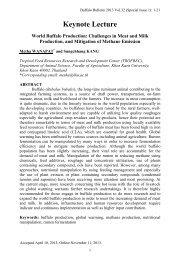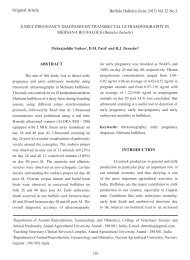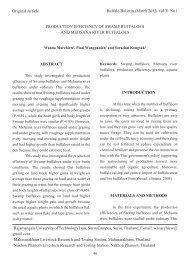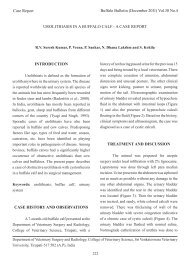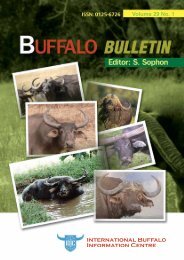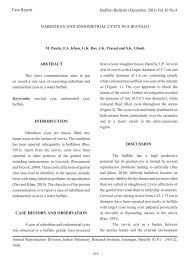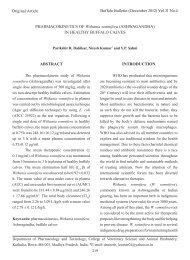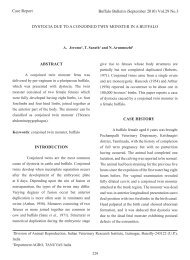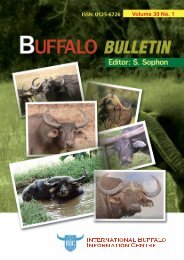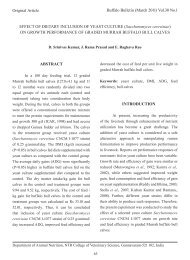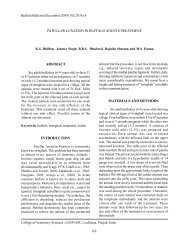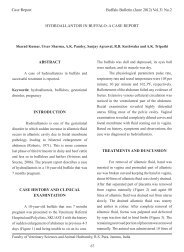value added buffalo meat sausage with potato flour as binder
value added buffalo meat sausage with potato flour as binder
value added buffalo meat sausage with potato flour as binder
Create successful ePaper yourself
Turn your PDF publications into a flip-book with our unique Google optimized e-Paper software.
Original ArticleBuffalo Bulletin (June 2010) Vol.29 No.2VALUE ADDED BUFFALO MEAT SAUSAGE WITH POTATO FLOUR AS BINDERR. Ponsingh 1 , R. Narendra Babu 2 , S. Wilfred Ruban 3 and V. Appa Rao 4ABSTRACTA study to determine the optimum level ofinclusion of three different levels of <strong>potato</strong> <strong>flour</strong> (3,5 and 7 percent) in <strong>buffalo</strong> <strong>meat</strong> <strong>sausage</strong>incorporated <strong>with</strong> 30 percent low-<strong>value</strong> <strong>meat</strong> w<strong>as</strong>carried out. The optimum level of <strong>potato</strong> <strong>flour</strong> w<strong>as</strong>determined by <strong>as</strong>sessing the physico-chemical(emulsion pH, product pH, emulsion stability, cookingyield and shear force <strong>value</strong>) and sensorycharacteristics. A highly significant (P
Buffalo Bulletin (June 2010) Vol.29 No.2binding capacities (Whiting, 1989 and Hendrick etal., 1994). Binders, especially those of plant origin,can be used in the product formulations tocompensate low functionality of such <strong>meat</strong> and offals(Bawa et al., 1998). Potato h<strong>as</strong> long been used by<strong>meat</strong> processors and can be processed into starchesand <strong>flour</strong> which can be used in <strong>sausage</strong>s <strong>as</strong> a <strong>binder</strong>or extender to incre<strong>as</strong>e water binding and improvecooking yield (Berry, 1997 and Hughes et al., 1998).Hence this study w<strong>as</strong> designed to evaluate theoptimum level of inclusion of <strong>potato</strong> <strong>flour</strong> <strong>as</strong> a <strong>binder</strong>in improving the stability of <strong>buffalo</strong> <strong>meat</strong> <strong>sausage</strong>.MATERIALS AND METHODSFresh <strong>buffalo</strong> lean <strong>meat</strong>, head <strong>meat</strong>, heart,tongue and fat were obtained from the <strong>buffalo</strong>esslaughtered at the Chennai Corporation slaughterhouse, Perambur. Meat from the head and cheekw<strong>as</strong> isolated and separable fat w<strong>as</strong> removed. Theheart w<strong>as</strong> cut open along its longitudinal axis andclotted blood w<strong>as</strong> removed. The epithelial layer oftongue w<strong>as</strong> scraped off, and then the tongue w<strong>as</strong>cut into small pieces. The lean <strong>meat</strong>, head <strong>meat</strong>,tongue, fat, and heart were packed in polyethylenebags separately and frozen at -20 o C. Potato <strong>flour</strong>w<strong>as</strong> prepared by scalding fresh <strong>potato</strong>es at 80 o Cfor 10 minutes and then peeling off the skin. Scalded<strong>potato</strong>es were cut into small pieces and dried in anoven at 60 o C overnight. The dried <strong>potato</strong>es wereground into a fine powder using a Cyclotec of 1 mmsieve.Preparation of Sausage: Sausages were preparedby using 50 percent lean <strong>meat</strong>, 30 percent low-<strong>value</strong><strong>meat</strong> (LVM- head, heart and tongue), 20 percentfat and <strong>with</strong> 3, 5 and 7 percent levels of <strong>potato</strong> <strong>flour</strong>individually (Table 1). Frozen <strong>meat</strong>, LVM and fatwere tempered at 4 o C and were cut into small piecesTable 1. Formulation for preparation of <strong>buffalo</strong> <strong>meat</strong> <strong>sausage</strong>.IngredientsPercentageLean MeatLow <strong>value</strong> <strong>meat</strong> (head, heart and tongue<strong>meat</strong> in the ratio of 70:15:15)Buffalo fatVegetable oil (sunflower)Sodium TripolyphosphateSaltAdded water (Ice)Spice mixGreen condimentsSodium nitriteBinder (Potato Flour)50301010 .1000.32.010.01.54.00.0123 or 5 or 7 percent122
Buffalo Bulletin (June 2010) Vol.29 No.2and minced using 4.5 mm plate in Electrolux mincer(Om<strong>as</strong>, Model-16789). LVM w<strong>as</strong> minced twice.Additives (sodium tripolyphosphate -0.3 percent, salt-2 percent and sodium nitrite-120 ppm), spice mix-1.5 percent, green condiments, chilled water(Ice)-10 percent were <strong>added</strong> and chopped along <strong>with</strong> <strong>meat</strong>and fat in a <strong>meat</strong> chopper. At the final step, <strong>potato</strong><strong>flour</strong> w<strong>as</strong> <strong>added</strong> and chopped for 1.5 minutes. Duringchopping, care w<strong>as</strong> taken to maintain the emulsiontemperature between 10-13 o C. From this emulsion,samples were taken for pH and emulsion stability.Sausage emulsion w<strong>as</strong> stuffed in sheep c<strong>as</strong>ing of19 mm diameter, using a manual <strong>sausage</strong> stufferand linked manually. Stuffed <strong>sausage</strong>s were kept ina refrigerator (4+1 o C) for 1 h to ensure propersetting. Sausages were then cooked in a water bathat 80 o C for 15 minutes until a core temperature of72+3 o C w<strong>as</strong> reached. Sausages prepared weresubjected to physicochemical and sensoryevaluation.Analysis: The pH w<strong>as</strong> me<strong>as</strong>ured using a digital pHmeter (Cyberscan pH 510, Merck). Emulsionstability w<strong>as</strong> estimated <strong>as</strong> per the method outlinedby Baliga and Madaiah (1971). The cooking yieldw<strong>as</strong> calculated <strong>as</strong> the difference in the weight ofthe <strong>sausage</strong> before and after cooking. The shearforce <strong>value</strong>s of cooked <strong>sausage</strong>s were <strong>as</strong>sessedusing Warner Bratzler Shear Press (Model No.04347, The G.R. MFG. Co., Manhattan, U.S.A.) andthe results were recorded <strong>as</strong> per method of Rao etal. (1999). Thio-barbituric acid reactive substance(TBARS) number and tyrosine <strong>value</strong> (TV) weredetermined using method of Tarladgis et al. (1960)and Strange et al. (1977), respectively. Organolepticquality w<strong>as</strong> evaluated by a semi-trained panel usinga nine-point hedonic scale (where nine w<strong>as</strong>extremely desirable and one w<strong>as</strong> extremelyundesirable).Statistical Analysis: Data were analyzed by thestatistical method of one way ANOVA using aSPSS@ software package developed <strong>as</strong> per theprocedure of Snedecor and Cochran (1994) andmeans were compared by using Duncan’s multiplerange test (Duncan, 1955).RESULTS AND DISCUSSIONThe mean <strong>value</strong>s on physicochemical andsensory characteristics of <strong>buffalo</strong> <strong>meat</strong> <strong>sausage</strong>s<strong>with</strong> different levels of inclusion of <strong>potato</strong> <strong>flour</strong> arepresented in Tables 2 and 3.The pH of both the emulsion and the productshowed a highly significant (P
Buffalo Bulletin (June 2010) Vol.29 No.2Table 2. Mean + S.E. <strong>value</strong>s of physico-chemical characteristics of <strong>buffalo</strong> <strong>meat</strong> <strong>sausage</strong> <strong>with</strong> different levelsof <strong>potato</strong> <strong>flour</strong>.PARAMETERSLEVELS OF POTATO FLOUR3% 5% 7%Emulsion pH 5.75+0.01 a 5.83+0.01 b 5.88+0.01 cProduct pH 5.80+0.012 a 5.88+0.010 b 5.93+0.010 cEmulsion stability (%) 92.79+0.23 a 94.71+0.17 b 95.98+0.24 bCooking Yield (%) 91.64+0.17 a 94.31+0.26 b 95.58+0.22 cShear Force(Kg/ 19 mm dia)0.54+0.01 a 0.63+0.019 b 0.68+0.01 cMeans bearing different superscripts (a, b, c) between rows differ significantly (P
Buffalo Bulletin (June 2010) Vol.29 No.2Table 4. Mean + S.E for physico-chemical characteristics of <strong>buffalo</strong> <strong>meat</strong> <strong>sausage</strong> <strong>with</strong> 5 percent <strong>potato</strong> <strong>flour</strong> at refrigerated storage (4+1 o C).Storage Days Mean + S.EParameter0 7 14 21 30pH 5.88 + 0.01 a 5.91 + 0.01 a 6.07 + 0.01 b 6.01 + 0.01 b 5.94 + 0.008 a 5.96 + 0.01 **Shear Force Value 0.57 + 0.01 a 0.67 + 0.01 b 0.77 + 0.006 c 0.85 + 0.01 d 0.99 + 0.007 e 0.77 + 0.01 **TBARS (mg of malanoldehyde/Kg) 0.35 + 0.004 a 0.65 + 0.008 b 0.75 + 0.007 c 0.85 + 0.008 d 0.97 + 0.005 e 0.71+ 0.01**Tyrosine Value (mg/100g of sample) 1.89 + 0.05 a 4.35 + 0.2 b 5.04 + 0.08 c 7.2 + 0.21 d 9.44 + 0.06 e 5.58 + 0.13 **Means bearing same superscripts (a,b,c,d,e) between rows do not differ significantly (P
Buffalo Bulletin (June 2010) Vol.29 No.2al., 1998). This may be due to the fact that starch in<strong>flour</strong> favours formation of strong heat inducedstructure through swelling of starch granulesembedded in a protein matrix (Berry and Wergin,1993).A highly significant difference w<strong>as</strong> observed<strong>with</strong> respect to appearance of <strong>sausage</strong>, <strong>with</strong> lowerscores for <strong>sausage</strong> incorporated <strong>with</strong> the 7 percentlevel followed by the 5 and 3 percent levels. The 5percent level recorded better flavor scores comparedto the other levels. An enhancement of flavourrele<strong>as</strong>e during m<strong>as</strong>tication may be due to the slowrele<strong>as</strong>e of bound water during physical breakdownallowing more effective flavour rele<strong>as</strong>e (Trout etal., 1992).A highly significant (p
Buffalo Bulletin (June 2010) Vol.29 No.2temperature on various physical, chemical andmicrobial characteristics of ground pork. J.Food Protect., 50(11): 948-951.Berry, B.W. 1997. Sodium Alginate plus modified<strong>potato</strong> <strong>flour</strong> improves properties of low fatbeef patties. J. Food Sci., 62(6): 1245-1249.Berry, B.W. and W.P. Wergin. 1993. Modifiedpregelatinized <strong>potato</strong> starch in low fat groundbeef patties. J. Muscle Foods, 4: 305-320.Bushway, A.A., P.R. Belyea, R.H. True, T.M. Work,D.O. Russell and D.F. McGann. 1982. Potatostarch and <strong>flour</strong> in frankfurters: Effect onchemical, sensory properties and Total viablecount. J. Food Sci., 47: 402-404, 408.Carballo, J., P. Fernandez., G. Barreto, M.T. Sol<strong>as</strong>and F.J. Colmenero. 1996. Morphology andtexture of bologna <strong>sausage</strong> <strong>as</strong> related tocontent of fat, starch and egg white. J. FoodSci., 61: 652-655.Choi, S.H. and K.B. Chin. 2003. Evaluation ofsodium lactate <strong>as</strong> a replacement forconventional chemical preservatives incomminuted <strong>sausage</strong>s inoculated <strong>with</strong> Listeriamonocytogenes. Meat Sci., 5: 531-537.Devatkal, S., S.K. Mendiratta and N. Kondaiah.2004. Quality characteristics of loaves from<strong>buffalo</strong> <strong>meat</strong>, liver and vegetables. Meat Sci.,67: 377-383.Drerup, D.L., M.D. Judge and E.D. Aberle. 1981.Sensory properties and lipid oxidation inprerigor processed fresh pork <strong>sausage</strong>. J.Food Sci., 46: 1659-1661.Duncan, D.B. 1955. Multiple range and multiple Ftests. Biometrics, 1: 1-8.FAO, Stat. 2003. Food and Agricultural Organizationof the United Nations. FAOSTAT datab<strong>as</strong>e.Hachmeister, K.A. and T.J. Herald. 1998. Thermaland rheological properties and texturalattributes of reduced fat turkey batters.Poultry Sci., 77: 632-638.Hendrick, H.B., E.D. Aberle, M.D. Judge and J.C.Forrest. 1994. Principles of Meat Science.W.H. Freeman and Co., San Francisco, 198.Hughes, E., A.M. Mullen and D.J. Tray. 1998. Effectof fat level, tapioca starch and whey proteinon frankfurters formulated <strong>with</strong> 5 and 12percent fat. Meat Sci., 48: 169-180.Modi, V.K., N.S. Mahendrakar, D. Nar<strong>as</strong>imha Raoand N.M. Sachindra. 2003. Quality of <strong>buffalo</strong><strong>meat</strong> burger containing legume <strong>flour</strong>s <strong>as</strong><strong>binder</strong>s. Meat Sci., 66: 143-149.Reddy, K.P. and B.J. Rao. 2000. Effect of <strong>binder</strong>sand precooking on quality of chicken loaves.J. Food Sci., 37: 551-553.Reddy, K.P. and K. Vijayalakshmi. 1998. Effect ofincorporation of skin, gizzard, heart and yolkon the quality of frozen chicken <strong>meat</strong> <strong>sausage</strong>.J. Food Sci. Technol., 35(3): 276-278.Sachindra, N.M., P.Z. Sakhare, K.P. Y<strong>as</strong>hoda andD.R. Nar<strong>as</strong>imha. 2005. Microbial profile of<strong>buffalo</strong> <strong>sausage</strong> during processing andstorage. Food Control, 16(1): 31-35.Sahoo, J. and A.S.R. Anjaneyulu. 1997. Effect ofnatural antioxidants and vaccum packaging onthe quality of <strong>buffalo</strong> <strong>meat</strong> nuggets duringrefrigerated storage. Meat Sci., 47(3/4): 223-230.Snedecor, G.W. and Cochran. 1994. StatisticalMethods. First E<strong>as</strong>t West Press Edition, NewDelhi.Strange, E.D., R.C. Benedict, J.L. Smith and G.E.Swift. 1977. Evaluation of rapid tests formonitoring alteration in <strong>meat</strong> quality duringstorage. I Intact Meat. J. Food Prot., 40:843-847.Suman, S. P. and B.D. Sharma. 2003. Effect of grindsize and fat levels on the physico-chemicaland sensory characteristics of low- fat ground<strong>buffalo</strong> <strong>meat</strong> patties. Meat Sci., 65(3): 973-976.127
Buffalo Bulletin (June 2010) Vol.29 No.2Tarladgis, B.G., B.M. Walts, M.T. Mounatham andL.R. Dugan. 1960. A distillation method forthe quantitative determination ofmalonaldehyde in rancid foods. J. Amer. OilChem. Soc., 37: 44.Thom<strong>as</strong>, R., A.S.R. Anjaneyulu and N. Kondaiah.2006. Quality and shelf life evaluation ofemulsion and restructured <strong>buffalo</strong> <strong>meat</strong>nuggets at cold storage(4+1 o C). Meat Sci.,72: 373-379.Trout, E.S., N.C. Hunt, D.E. Johnson, J.R. Claus,C.L. K<strong>as</strong>hner and O.H. Krolpf. 1992.Chemical, physical and sensoryCharacteristics of ground beef containing 5-30 percent fat. J. Food Sci., 57(1): 25-29.Whiting, R.C. 1989. Contribution of collagen toproperties of comminuted and restructured<strong>meat</strong> product. Reciprocal Meat ConferenceProceedings, 42: 149-155.*Continued from page 114M<strong>as</strong>ri, S.A., W. Olson, P.T. Nguyen, S. Prins andD. Deregt. 1996. Rapid detection of bovineherpesvirus-I in the semen of infected bullsby a nested polymer<strong>as</strong>e chain reaction <strong>as</strong>say.Can. J. Vet. Res., 60(2): 100-107.Santrude, G., N.D.V. Siva, R. Tabares, E. Solana,A. Bautista and J.M. C<strong>as</strong>tro. 1996. Rapid andhigh sensitivity test for direct detection ofbovine herpes virus-1 genome in clinicalsamples. Vet. Microbial., 49: 81-92.Steel, R.G.D. and J.H. Torrie. 1984. MultipleComparisons. In Principles and Proceduresof Statistics. McGraw-Hill International BookCompany Singapore. 2: 172-194.Von Stedingk, L.V., I. Olsson, H.S. Hanson, E.Asbrink and A. Hovmark. 1995. Polymer<strong>as</strong>echain reaction for detection of Borreliaburgdorferi DNA in skin lesions of early andlate Lyme borreliosis. Eur. J. Clin. Microbiol.Infect. Dis., 14: 1-5.Walsh, P.S., D.A. Metzger and R. Higuchi. 1991.Chelex OR100 <strong>as</strong> medium for simple extractionof DNA for PCR-b<strong>as</strong>ed typing from forensicmaterial. Biotechniques, 10: 506-513.*Continued from page 120Utiger, R.D. 1974. Serum triiodothyronine in man.Ann. Rev. Med., 25: 289-302.Wilson and Walker. 2000. Practical Biochemistry.Wiley E<strong>as</strong>tern, New Delhi.Yao, Y. 1975. Thyrotropin rele<strong>as</strong>ing hormone, clinicaluses, NY State J. Med., 75(9): 1413-1416.Young, D.S., L. Pestaner and U. Gibberman. 1975.Effects of drugs on clinical laboratory tests.Clin. Chem., 21(5): 3660.128



